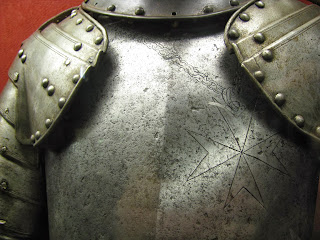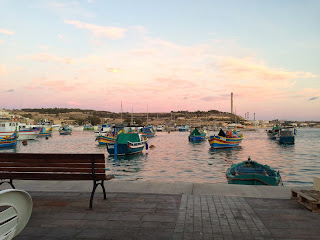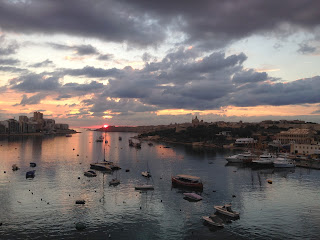Day One:
We left for Malta at an ungodly early hour
(AKA Ass-Crack of Dawn). Our cab from
the airport to Valletta (the capital) took only fifteen minutes, the first hint
at just how small Malta really is. We
found the place we were staying and I was pretty surprised. We had made the reservations so long before
that I had forgotten that we had a small house for the first two nights and
not just a private hostel room. The lady
who owns it met us and took us into the tiny galley kitchen, flanked by the
bathroom. At the end of the kitchen a
stone staircase, its steps bowed with centuries of wear, led to the first
floor/second floor (depending on your nationality). The first floor was one large room with a
tiny balcony. All in all it was a really
nice place, especially for the amount we paid.
After settling in and taking showers we
went for a walk. But before I go much
further, a history lesson:
The Phoenicians settled Malta about 3,000
years ago. Though the country (which
consists of three main islands: Malta, Comino and Gozo) is tiny, it is
strategically located in the Mediterranean about halfway between the southern
tip of Sicily and the Northern tip of Tunisia.
The Romans, Arabs, and Normans invaded and controlled the island over
the centuries, until the 16th century, when Charles V of Spain
gained control of the island (along with Sicily).
Meanwhile, in Rhodes, The Knights of St
John of Jerusalem where fighting their arch-enemies, the army of Suleiman the
Magnificent of the Ottoman Empire.
Rhodes had fallen to the Ottomans in 1523 and the knights spent years
begging the crowns of Europe to give them a home. Eventually, Charles V gave the knights
control of Malta. Charles was hoping
that the presence of the knights, known for their fighting skill and their
mission to protect Christian Europe from the Ottoman Empire, would help to
secure the Mediterranean. All
seemed well for a time, until 1565, when Suleiman decided that Malta must be
conquered to both secure more land for his empire, and to humble the
knights.
The next section in the story, called The
Great Siege, is too long and complicated to write about here. But I will give a brief outline and just say
that it is an extremely interesting event to read about. Ernle Bradford’s book The Great Siege: Malta 1565 is hard to put down (Kathy, I am going
to mail you my copy).
The Ottomans sent one of the largest
forces every mustered to conquer the island.
The Knights where based in Grand Harbour on two peninsulas, Birgu and
Senglea, as well as a third unnamed peninsula, at the point of which stood Fort
St Elmo. The Knights and the Maltese had
time to prepare for the siege, and all across the Malta and Gozo people settled
in for the long haul. The first action by
the Turks was to secure Fort St Elmo, and thus gain access to the harbour on
its northern side. What the Turks
thought would take days took over a month, lasting from May 24th to the 25th of
June.
Long story short, the Turks lost miserably
after they won St Elmo. Over the course
of the Summer they made great advances on Senglea and Birgu, nearly capturing
all and winning a few times, but each time something made them turn back
(including a very small raiding party on their camp, which made the entire army
turn around, fearing it was a force sent from Spain, and not a few hundred men
from the center of the island).
The Turks were destroyed and sent home with
their tale between their legs. Suleiman
was humiliated and Christian Europe, even the Protestant Queen Elizabeth I,
praised the knights and the Maltese for their work. Eventually the peninsula on which For St Elmo
stood was to become the home of the knights and named Valletta, after the Grand
Master who oversaw the defeat of the Turks, Jean Parisot de la Vallette.
Ok, more history later, but now on to what
Tom and I did. We went for lunch and
found a restaurant recommended to me by a Maltese customer who came into the
shop of few months before: Luciano’s. It
was conveniently located next to St John’s Co-Cathedral. After lunch I successfully dragged Tom into
the cathedral.
 |
| The cathedral. |
It is a Co-Cathedral because the main
cathedral of Malta is in Mdina, but St John’s in Valletta is so important that
it was elevated to the status of Co-Cathedral by the pope. It is a Baroque masterpiece.
 |
| Tomb Stone of one of the orders of The Knights of St John |
 |
| Screen at a confessional. |
 |
| One of the altars in the cathedral. The lighted area under the altar holds en entire corpse of a saint or a martyr. |
 |
| The high altar. |
 |
| Another tombtone. |
 |
| Tom is engrossed in the audioguide. |
We did not know what to do next so we just walked through the narrow streets, eventually finding a terraced restaurant near the Saluting Battery (more on that later) that looked across Grand Harbour to Birgu (also called Vittoriosa, or The Victorious City). The rest of the day was really relaxed. We just walked around Valletta (which is tiny), ate dinner and drank the local beer, Cisk (pronounced CHI-sk).
 |
| Grand Harbour. |
 |
| I may be in the stocks, but I still want my beer. |
 |
| Tom pointed out that I never know what to do with my hands in pictures. |
 |
| Tom attempts to hide, disguised as a local. |
 |
| They are hard to see, but there were two pigeons attempting to flirt in the middle of this picture. |
 |
| You can see Birgu (left) and Senglea (right) on Grand Harbour,across from the Saluting Battery. |
 |
| How we pose. |
 |
| A more accurate representation of our relationship. |
 |
| Upper Barraka Gardens, above the Saluting Battery. |
 |
| Tom was thrown in the stocks as well. |
Day Two
The next day we went to the Palace of the
Grand Master, which now serves as the houses of parliament and the palace of
the President of Malta. It was nice, but
there was absolutely nothing describing what it was we were looking at, so it
was hard to appreciate. The Armoury was
interesting, especially the collection of arms and armour taken from the Turks
as they fled the island.
 |
| Entry to the palace. |
 |
| Inner courtyard of the palace. |
 |
| Once again, Tom tries to blend in. |
 |
| Mural showing the defeat of the Turks in 1565. |
 |
| The contestants square off. |
 |
| Apparently you aren't allowed to touch the armour. |
 |
| Armour of one of the knights showing the Maltese Cross. |
 |
| Captured Turkish armour and weapons. |
 |
| GUN SWORD!!! No, seriously! |
 |
| Jean Pirasol de la Vallette's armour he wore during the siege. |
 |
| Tom points. |
As we made our way to the water front to
take the water taxi over to Birgu we arrived at the Saluting Battery just in
time to see the firing of the noon cannon.
Men dressed in British Colonial Army uniforms (complete with pith
helmets!) fire a cannon every day at noon and 4pm. This was something required by the British in
all their ports across the empire, and was revived in Malta in 2004 as a
tourist show and a way to raise money for the care of various historical sites.
 |
| Grand harbour from the Saluting Battery. |
 |
| Tom, trying to show his strength. |
 |
| Note the awkward hands, again. |
We went across to Birgu and had a beer on
the square. The square is the spot where
Jean de la Vallette commanded the entire defence of the Malta during the Great
Siege (I may have history nerded out).
We met a Maltese woman who recommended we go to a small fishing village
called Marsaxlokk for seafood and swimming.
It was interesting because she said she only talked to us because we
were British, as she can’t understand non-British English speakers (never mind
that she could understand me, an American).
 |
| The square in Birgu. |
Now, MORE HISTORY!!!!!!
In 1798 Napoleon conquered Malta very
easily. He needed the island for
strategic reasons for his invasion of Egypt.
He spent only four nights on Malta before going on to Egypt and leaving
a small group of 4,000 men to keep the island.
The men ravaged the churches (not a good thing, since Malta is
considered to be one of the most Catholic countries in Europe) and once news of
his defeat in Egypt by the British spread, the Maltese rose up and cornered the
French in Valletta. Napoleon lost in
Egypt mostly because of the British Navy, who destroyed his own Navy.
In the Treaty of Amiens (1802) the islands
were to be given back to the Knights of St John, but the Maltese protested and
asked to become part of the British Empire, thus protecting themselves with the
most powerful country at the time. In
1804, after the later stages of the Napoleonic War broke out and Britain saw
the usefulness of a Mediterranean base, the British gave in and Malta became a
member of the British Empire (it gained its independence in September 21,
1964).
This colonial history explains some strange
things on the island, like the prevalence of red British phone boxes and post
boxes, as well as the colonial costumes worn by the men at the Saluting Battery.
In Birgu we went to the Malta at War
museum. Most of the displays were
boring, long-winded and dry, but it was the last section of the museum that we
were excited about. The museum ends with
a tunnel down into actual bomb shelters carved in to the stone where people
spent many days during the WWII bombing raids by the Italians and Germans
between 1940 and 1942. Malta was
important then for the same reason it has always been: its strategic location.
Remarkably the Maltese withstood the
bombings, and King George VI awarded the entire population of Malta The George
Cross, the highest award for civilian bravery, the only time it has ever been
granted to a group and not an individual.
Later that afternoon we took a taxi to
Marsaxlokk and walked to the cove known as St Peter’s Pool to go swimming. Because of the currents surrounding Malta,
there are only two (I think) natural sand beaches, the rest are rocky shelves,
like St Peter’s.
 |
| St Peter's Pool |
Tom wanted to get seafood and so we looked
for a place on the harbour back in Marsaxlokk.
We found one and Tom had a local fish called lampuki. I had pasta.
Maltese cuisine seems to be heavily influenced by Italian, and as a
result I had a lot of pasta on the trip.
It was rare to see something vegetarian that was not pasta or pizza.
Day Three
We had to change hotels this day and took a
taxi to Sliema, which is just across the bay from Valletta. Instead of a small house we had a normal
hotel room. This was a very relaxing, do
nothing day. We went to a beach in St
George’s Bay in the neighbouring town of St Julian’s and then had dinner in an
area called Paceville. It was an amazing
dinner, easily the best we had the whole trip.
I have mushroom risotto and Tom had octopus cooked in wine, plus we
shared a starter of fried goat cheese from Gozo.
 |
| The view from our hotel room. |
 |
| The view from my lunch table. |
 |
| St George's Bay. |
 |
| St George's Bay. |
 |
| Fried cheese appetiser. DELICIOUS! |
 |
| Tom's octopus. |
Day Four
Tom and I bought a voucher for a special
deal online. We took a cruise around the
entire island of Malta, stopping at The Blue Lagoon on Comino (a very tiny,
uninhabited island). The boat was a 60
or 70 foot Turkish Gullet (according to the brochure, I am not up to date on my
traditional Mediterranean modes of sea travel).
It was so much fun. We sat on the
bow of the boat for the cruise to the lagoon.
I got a bit of a sun burn on my face (45 SPF, my ass) and drank more
Cisk.




The crew cooked lunch as we got to the
lagoon, where we docked and Tom and I took a quick boat tour of the caves
dotting the coast of Comino. Back on
shore we looked around a bit at the very crowded, very tiny beach and headed back to the
boat to swim and dive off it for the next hour.
The crew threw bread and meat overboard to attract fish. They were so
cool, it reminded me of Hanama Bay in Hawai’i.
I was not going to waste a minute of the fun, so I spent about 20
minutes climbing up the small ladder, out of the water and jumping into the
water. I felt like a ten year old who hadn’t
been in the water all winter and just wanted to keep diving in.
 |
| The spire on the right is of an Anglican church built in the 1800s. The dome on the left is a catholic church. The catholic church was built specifically yo be taller than the Anglican one. |
 |
| Fishermen. |
 |
| The white tent covers an ancient temple complex older than the pyramids. |
I don't know where else to put this so I will put it here. Malta has the highest population density in Europe and only one or two, small natural sources of fresh water. As a result thee are two desalination plants on the island that turn sea water into fresh water. One man told us that it is not uncommon in the summer to have you water bill be higher than your other bills combined. Because of the desalination, the water in Malta tastes funny. There is no saltiness to it, but you can tell it was once sea water.
Back at the hotel Tom and I saw that there
was a one day trip to Sicily being offered by a lot of the tour group
stalls. We decided to do it for our last
day, since we did not have to be at the airport until pretty late. Sadly, the
tour gets back from Sicily later than was feasible, so we had to pass on it. However, this meant we needed to look for
something to do on Friday, and Tom suggested an intro to scuba diving thing he
found. We called up arranged for it for
the next day.
For out last night we went back to
Paceville and had dinner before ending the night early at a hookah-shisha
bar.
Day five
We woke up early to get ready for the scuba
class and were picked up by the instructor, Anne (from Japan). It turned out that Anne came to Malta because
she was working in Libya three years ago and wanted to go on a scuba diving
vacation (which she had been doing for year).
Her timing was good though, as the revolution started in Libya while she
was in Malta, so she decided to stay.
Also, she lived in Seattle for five years!
Scuba diving is amazing. We walked into the water and slowly made out
way out, following the seafloor. It was
not until about ten minutes in that I looked up and realised how deep down we
were. It was amazing to look up and see 30
feet of water above your head, the sun shining through and schools of fish
swimming overhead. I definitely want to
do it again. Tom and I agree that it was
the best thing we did on the entire trip.
Had we done it earlier and had time to do the next class we would have. I am seriously thinking about getting into it
more.
We had sushi at a restaurant Anne recommended. Tom loves sushi, but I usually don't like the
seaweed, it tastes too much like fish to me and I don't like that. For some reason, though, this sushi was
amazing! I could not taste any fishiness
in the seaweed and had to stop myself from ordering more.
The rest of the day was spent back at St
George’s bay, enjoying the last moments of sun before returning to England,
where the news was forecasting the biggest storm in 26 years to hit two days
after we got back.
 |
| Double fisting sushi. |
 |
| Last ice cream in Malta. |
We had dinner and left for the airport, not
wanting to leave just yet.
































































































































No comments:
Post a Comment